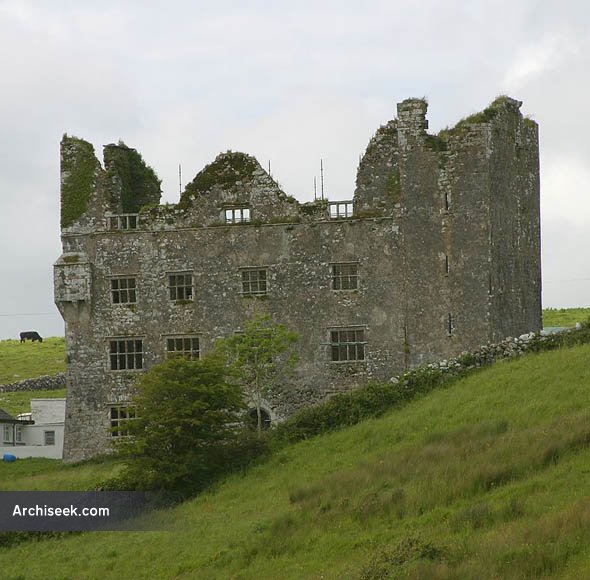Maura Rhue McMahon (Mary O'Brien), also known as "Red Mary", her red-haired ghost was reputed to haunt the long front avenue of Lemaneagh Castle, near the 'Druids' altar'. Here is the legend...

We would like to dedicate this blog to our father Eugene Michael McMahon. His mother Catherine Creagh arrived in the US in 1914 and his father Thomas McMahon arrived in the US in 1909. They both landed on Ellis Island. They were married and Catherine died when my dad was 2. He was separated from his siblings and was raised by his aunt on the Creagh side. Mark McMahon has inspired this blog by sharing with me his passion for finding our McMahon ancestors.

"the noble and beautiful seat of Sir Lucius O'Brien, Bart., in the county of Clare, situated on a hill gently rising from a lake of twenty four acres in the middle of woods. Three beautiful hills rise above it, commanding fine prospects of the great rivers Fergus and Shannon at their junction, being each of them a league wide."Sir Lucius O'Brien was the eldest son of the first Sir Edward. Lucius was the 3rd Baronet. He died in 1794. His son, the second Sir Edward, was the 4th Baronet. Edward decided to rebuild the castle. In 1821, it was the birthplace of Edward's brother Robert's son, George O'Brien (painter). Work began around 1822 and cost about Ј50,000 to complete. The Pain brothers submitted some classical designs but Edward O'Brien chose their neo-gothic designs, influenced by John Nash. James and George Richard Pain had been pupils of Nash in England. The building was completed in 1835. Samuel Lewis writing in 1837 described Dromoland as:
"a superb edifice in the castellated style, lately erected on the site of the ancient mansion, and surrounded by an extensive and richly wooded demesne, in which great improvements have recently been made".Edward was married to Charlotte Smith and her inherited wealth was probably essential in covering construction costs of their new mansion. Edward and Charlotte were parents of William Smith O'Brien, the leader of the Young Irelander rebellion of 1848. Sir Edward died in 1837. His eldest son Lucius was 5th Baronet and 13th Baron Inchiquin.
"It is built entirely of dark blue limestone, and in fine chiseled workmanship; the ornamental grounds and woods extend over more than 1,500 [6.1 km2] of land…from some of the eminences there are views of the Shannon and Fergus, which, at this part of the country, resembles a large inland lake with island, making Dromoland one of the most beautiful and desirable residences in Ireland."Dromoland has been preserved with little change since that time. The mansion is in "baronial" or "gothic revival" style. It has four linked irregular castellated turrets. A gothic porch to the north front displays the O'Brien arms. The western portion faces out to the lake, and the east towards the hill where Thomond House now stands. The large walled gardens are to the south. In 1902 the 15th Baron Inchiquin, Lucius, took the old 17th century gateway from Leamaneh and erected it at the entrance to the large walled garden. A long curving drive leads from the gateway and classical lodge, passing north of the lake and round to the front door of Dromoland Castle.

 The history of Doonbeg Castle in County Clare, Ireland - McMahon and O'Brien Irish genealogy
The history of Doonbeg Castle in County Clare, Ireland - McMahon and O'Brien Irish genealogy 


This is one of the most numerous surnames in County Clare and
said to be derived from the Irish word "mathganham", meaning "son of a bearlike
man." Holders of this name may claim descent from Mahon, son of Murtagh Mór Ó
Briain, King of Munster who was interred in St. Flannan's Cathedral, Killaloe,
early in the 12th century. The richly carved Romanesque doorway within the
Cathedral is said to mark the entrance to his tomb.
Two ruling branches of the clan became firmly established in Corcabaskin, West Clare, where their once strongholds, Carrigaholt Castle and Clonderlaw Castle, are prominent landmarks and a source of local interest today. Several McMahons took prominent roles during the course of history in Thomond, Teige Caech McMahon rose in rebellion against the English authorities and was the only local chieftain to lend support to Red Hugh Ó Donnell and participate in the last great battle of Kinsale for the survival of the Gaelic chieftains. Many other McMahons were later to distinguish themselves in far-flung fields of battle. |


